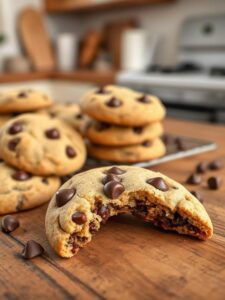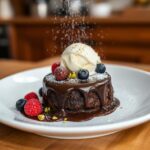When I first ventured into gluten-free baking, I quickly realized it wasn’t just about following a recipe — it was about understanding how ingredients behave without gluten. The texture, flavor, and even the way the batter comes together can feel entirely different from traditional baking. But here’s the good news: with the right approach, making gluten-free desserts can be just as satisfying — if not more so — than their wheat-based counterparts.
If you’re a beginner, you might feel overwhelmed by the new flours, unfamiliar textures, and endless advice scattered across the internet. I’ve been there too. That’s why I’ve created this detailed guide — so you can start baking gluten-free with confidence and excitement rather than stress. You don’t need years of experience; you simply need the right knowledge, tools, and a willingness to experiment.
By the end of this article, you’ll know how to choose the right ingredients, avoid common mistakes, and create desserts that not only meet gluten-free needs but also delight everyone who tastes them — whether they follow a gluten-free diet or not.
Why Go Gluten-Free?
Going gluten-free isn’t just a passing trend; for many people, it’s a necessity. Some individuals have celiac disease, an autoimmune condition where even small amounts of gluten can damage the small intestine. Others experience gluten sensitivity or allergies, which can lead to discomfort and fatigue. But beyond health concerns, there’s also a growing curiosity among bakers to explore gluten-free recipes simply for their unique flavors and textures.
When I first started creating gluten-free desserts, I was surprised at how different — and sometimes more exciting — they could taste. Nut flours, coconut flour, and other gluten-free ingredients bring subtle nutty notes, extra moisture, and distinctive aromas that wheat flour simply doesn’t offer. In some recipes, these characteristics can elevate the dessert, making it richer and more flavorful.
Another reason to embrace gluten-free baking is inclusivity. When you make a gluten-free dessert for a gathering, you ensure that friends and family with dietary restrictions can enjoy it without worry. There’s nothing better than watching everyone at the table enjoy the same dessert without anyone feeling left out.
Understanding Gluten-Free Baking Basics
Gluten plays a crucial role in traditional baking. It gives dough its elasticity, helps trap air during rising, and contributes to the chewy or fluffy texture in breads and cakes. Without gluten, baked goods can sometimes turn crumbly or dense — unless you understand how to replace its function.
In gluten-free baking, structure often comes from a combination of flours and binders. Instead of using just one type of flour, I rely on blends. Rice flour, almond flour, oat flour, and tapioca starch are some of my go-tos. They each bring different qualities: rice flour keeps things light, almond flour adds moisture and flavor, and tapioca starch helps with chewiness.
Binders like xanthan gum or guar gum mimic the elasticity of gluten. Without them, your cookies might fall apart in your hands, and your cakes could crumble when sliced. Using these in the right amount is key — too much and you’ll end up with a gummy texture, too little and your dessert will collapse.
Moisture balance is another important factor. Gluten-free flours can absorb liquid differently than wheat flour, so you might need to adjust the wet-to-dry ingredient ratio. I recommend keeping a close eye on the batter’s consistency rather than relying solely on the clock or a recipe’s baking time.
To help you get started, here’s a quick reference table for some common gluten-free flours and their characteristics:
| Flour Type | Texture Contribution | Best Used For |
|---|---|---|
| Rice Flour | Light, slightly gritty | Cookies, pancakes, light cakes |
| Almond Flour | Moist, nutty flavor | Muffins, brownies, tart bases |
| Coconut Flour | Dense, absorbs liquid | Energy balls, dense cakes |
| Oat Flour | Soft, mild flavor | Breads, muffins, pancakes |
| Tapioca Starch | Chewy, elastic | Flatbreads, cookies, crusts |
Once you know how each flour behaves, you can start combining them for the perfect texture and taste. I often mix two or three types in one dessert to balance flavor, structure, and moisture.
Essential Tools for Gluten-Free Dessert Making
While you can certainly start with just a mixing bowl and a spoon, having a few essential tools will make your gluten-free baking journey much smoother. I’ve learned that precision and consistency are key in gluten-free baking, and the right tools help achieve that.
First, invest in a digital kitchen scale. Unlike wheat-based baking, gluten-free recipes are far less forgiving when it comes to measuring errors. A scale ensures you get the exact amount of each flour, starch, and binder every time. This precision will make your results far more consistent.
Next, I recommend using a stand mixer or hand mixer. Some gluten-free batters require extra mixing to fully hydrate the flours and activate the binders. A good mixer saves time and energy — especially if you bake frequently.
A good set of measuring spoons, silicone spatulas, and parchment paper are also must-haves. Silicone spatulas are perfect for scraping every bit of batter from the bowl, and parchment paper helps prevent sticking, which can be a bigger issue in gluten-free baking.
If you’re serious about achieving bakery-quality results, consider adding an oven thermometer to your toolkit. I’ve lost count of how many times desserts failed simply because the oven ran hotter or cooler than the dial suggested. With gluten-free recipes, an incorrect temperature can mean the difference between a moist cake and a dry, crumbly disappointment.
Common Mistakes Beginners Make (and How to Avoid Them)
When I first started baking gluten-free, I made nearly every mistake you can think of. Over time, I learned that most of these errors could be avoided with a little understanding and a few simple habits.
One of the most common mistakes is treating gluten-free flour like wheat flour. They don’t behave the same way, so a one-to-one swap without adjusting liquids, binders, and baking times often leads to disappointing results. If you replace regular flour with only rice flour, for example, you’ll likely end up with something gritty and dry. Always use a balanced flour blend.
Another mistake is skipping the binder. Gluten-free recipes usually call for xanthan gum, guar gum, chia seeds, or flaxseed meal to help hold everything together. Leaving this out may seem harmless, but without it, your cookies may fall apart before they reach the plate.
Overmixing can also cause trouble. While wheat-based batters risk developing too much gluten with excessive mixing, gluten-free batters can become overly dense if you overwork them. I mix just until everything is combined and smooth, then stop.
Finally, beginners often bake at the wrong temperature or for too long. Gluten-free desserts dry out faster than traditional ones, so keep a close eye on them near the end of the baking time. A toothpick test is your best friend here — if it comes out with just a few moist crumbs, it’s ready.
Choosing the Right Gluten-Free Flour
The flour blend you choose can make or break your dessert. I’ve experimented with dozens of options over the years, and I can tell you there’s no universal “best” gluten-free flour. It depends entirely on the dessert you’re making.
For light, fluffy cakes, I often turn to a mix of rice flour, tapioca starch, and a small amount of potato starch. This combination mimics the structure of wheat flour while keeping the crumb soft. If I’m baking cookies, I might use oat flour for a tender texture along with almond flour for richness.
Almond flour is a favorite of mine because it adds both flavor and moisture. However, it’s heavier than rice flour, so I rarely use it alone. Coconut flour, on the other hand, is extremely absorbent and needs more eggs or liquid to keep the dessert from becoming dry and dense.
I recommend keeping at least three different gluten-free flours in your pantry so you can mix and match depending on the recipe. A ready-made gluten-free flour blend can be convenient for beginners, but I encourage you to eventually create your own blends for better flavor control.
Here’s a quick flavor and texture guide for pairing flours:
| Dessert Type | Recommended Flours |
|---|---|
| Light Cakes | Rice flour + tapioca starch + potato starch |
| Chewy Cookies | Oat flour + almond flour + tapioca starch |
| Dense Brownies | Almond flour + cocoa powder + arrowroot |
| Muffins | Oat flour + rice flour + potato starch |
| Pie Crusts | Almond flour + tapioca starch + sorghum flour |
When you understand how each flour behaves, you can create desserts that taste just as good — if not better — than traditional recipes.
Sweeteners & Flavor Enhancers for Gluten-Free Desserts
One of the best parts about gluten-free baking is that it encourages creativity with flavor. Since you’re already stepping outside the traditional flour box, why not experiment with sweeteners and enhancers that can make your dessert stand out?
While white sugar works perfectly fine, I often use alternatives like coconut sugar, honey, or maple syrup to add a richer flavor profile. Coconut sugar, for example, has a subtle caramel taste that pairs beautifully with chocolate-based desserts. Maple syrup can add a warm depth to muffins or pancakes, and honey works wonders in fruit-based treats.
For extra flavor, I love using natural enhancers such as pure vanilla extract, citrus zest, cinnamon, and nutmeg. These ingredients can mask any slight aftertaste that sometimes comes with certain gluten-free flours, especially bean-based ones.
Another trick I use is adding a pinch of salt — even in sweet recipes. It balances flavors and brings out the sweetness without making the dessert taste salty. I also find that toasting nuts before adding them to the batter can amplify their aroma and add a satisfying crunch.
When using liquid sweeteners, remember to slightly reduce the other liquids in your recipe to maintain the right batter consistency. For example, if I use maple syrup instead of sugar, I’ll cut back on milk or water by a tablespoon or two.
Step-by-Step Beginner Recipe: Easy Gluten-Free Chocolate Chip Cookies
When I want to show beginners how approachable gluten-free baking can be, I start with chocolate chip cookies. They’re familiar, forgiving, and always a crowd-pleaser — even for those who don’t usually eat gluten-free.
Ingredients:
-
1 ½ cups gluten-free all-purpose flour blend (with xanthan gum included)
-
½ teaspoon baking soda
-
¼ teaspoon salt
-
½ cup unsalted butter, softened
-
½ cup brown sugar, packed
-
¼ cup white sugar
-
1 large egg
-
1 teaspoon pure vanilla extract
-
1 cup gluten-free chocolate chips
Instructions:
-
Preheat your oven to 350°F (175°C) and line a baking sheet with parchment paper.
-
In a small bowl, whisk together the flour blend, baking soda, and salt.
-
In a larger bowl, beat the butter, brown sugar, and white sugar until creamy.
-
Add the egg and vanilla extract, mixing just until combined.
-
Gradually mix in the dry ingredients, followed by the chocolate chips.
-
Scoop spoonfuls of dough onto the prepared baking sheet, leaving space between each cookie.
-
Bake for 10–12 minutes, or until the edges are lightly golden.
-
Let them cool on the sheet for 5 minutes before transferring to a wire rack.
These cookies have a soft, chewy center and a slightly crisp edge. They’re the perfect starting point for learning how gluten-free dough behaves and bakes.
Alternative Easy Gluten-Free Dessert Ideas
Once you’ve mastered the basics, it’s fun to branch out into other easy recipes. Some of my favorites for beginners include flourless brownies, almond flour muffins, and no-bake energy balls.
Flourless brownies rely on cocoa powder and eggs for structure, which means there’s no need to worry about flour blends at all. Almond flour muffins are light, flavorful, and require only a few pantry staples. No-bake energy balls are practically foolproof — you just mix oats (make sure they’re certified gluten-free), nut butter, honey, and your choice of add-ins like chocolate chips or dried fruit.
If you’re hosting a dinner party, a gluten-free fruit crisp is a beautiful option. Simply top fresh fruit with a mixture of oat flour, oats, butter, and a touch of sugar, then bake until golden. It’s warm, comforting, and pairs perfectly with a scoop of vanilla ice cream.
How to Store Gluten-Free Desserts
One thing many beginners overlook is how to store their creations. Gluten-free desserts can dry out faster than traditional ones, so proper storage is essential.
For cookies, I store them in an airtight container at room temperature for up to three days. If I need them to last longer, I freeze them in a single layer on a baking sheet before transferring them to a freezer bag. This prevents them from sticking together.
Cakes and muffins stay moist longer if wrapped individually in plastic wrap and then stored in an airtight container. For items like brownies, I keep them covered tightly with foil or plastic wrap to lock in moisture.
When freezing, always let your dessert cool completely before wrapping. Placing warm baked goods into storage can cause condensation, which leads to soggy textures when thawed.
Tips for Perfecting Your First Gluten-Free Dessert
The best way to improve your gluten-free baking skills is to take notes. Every oven, flour blend, and even the humidity in your kitchen can affect the final result. I keep a small baking journal where I jot down what worked, what didn’t, and what I’d change next time.
Don’t be afraid to tweak recipes. If your cake is too dense, try swapping part of the flour for a lighter one like rice flour or adding a bit more leavening agent. If your cookies spread too much, chill the dough for 30 minutes before baking.
Remember, gluten-free baking is less about strict rules and more about understanding the relationships between ingredients. Once you get the feel for it, you’ll be able to adapt almost any recipe to suit your needs.
Serving Suggestions & Presentation Tips
A well-presented dessert feels extra special, even if it’s something as simple as a cookie. I like to serve gluten-free desserts with a few thoughtful touches — a dusting of powdered sugar over brownies, a drizzle of melted chocolate on cakes, or a sprinkle of chopped nuts for texture.
Plating also matters. Use a clean white plate to let the colors of your dessert pop, or add fresh berries on the side for a burst of freshness. If you’re serving a warm dessert like fruit crisp, pair it with a cold element such as vanilla ice cream or whipped cream for contrast.
FAQs About Gluten-Free Desserts for Beginners
Do I need special equipment for gluten-free baking?
Not necessarily. The basics — mixing bowls, measuring cups, a whisk, and baking sheets — are enough to get started. However, a digital scale and stand mixer can make your results more consistent.
Can I use regular recipes and just swap the flour?
Sometimes, but not always. Gluten-free flours absorb moisture differently, so you’ll often need to adjust liquids, baking time, and binders.
Is gluten-free baking healthier?
Not automatically. While it’s essential for those with gluten intolerance or celiac disease, gluten-free desserts can still be high in sugar and fat. The healthiness depends on the ingredients you choose.
Conclusion
When I look back at my early gluten-free baking days, I remember the excitement of pulling something from the oven that not only looked good but tasted amazing — and knowing it was safe for friends and family who couldn’t have gluten.
The journey from beginner to confident baker doesn’t happen overnight, but every dessert you make teaches you something new. With the right flours, a few key tools, and an understanding of how ingredients work together, you’ll soon be creating gluten-free treats that everyone will love.
And the best part? You’ll realize that gluten-free isn’t a limitation — it’s simply a different, and equally delicious, way to bake.




